Strategic Report: Evaluating Asda's Position in Global Business
VerifiedAdded on 2023/06/11
|11
|2927
|207
Report
AI Summary
This report provides a comprehensive analysis of Asda's global business strategy, evaluating both the external and internal environments using tools like PESTLE and VRIO frameworks. It delves into the political, economic, social, technological, legal, and environmental factors impacting Asda, as well as assessing its valuable, rare, inimitable, and organization-specific resources. The report further conducts a SWOT analysis to identify Asda's strengths, weaknesses, opportunities, and threats, culminating in strategic recommendations based on the SAF framework. Key suggestions include enhancing food product quality to mitigate competitive threats and leveraging financial resources to expand operations in foreign markets. This detailed analysis aims to provide actionable insights for Asda to improve its competitive positioning and achieve sustainable growth. Desklib provides a platform to explore similar solved assignments and study tools for students.
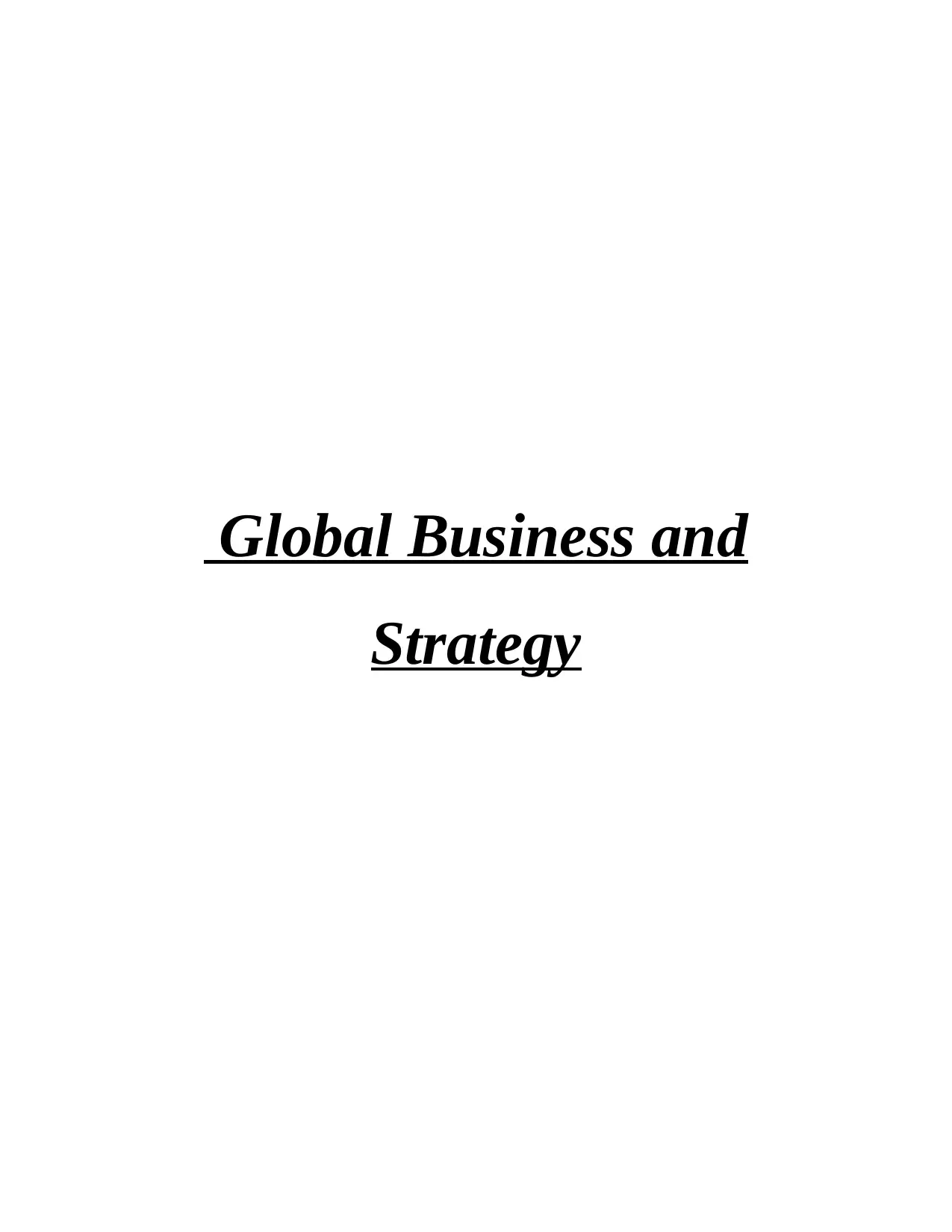
Global Business and
Strategy
Strategy
Secure Best Marks with AI Grader
Need help grading? Try our AI Grader for instant feedback on your assignments.
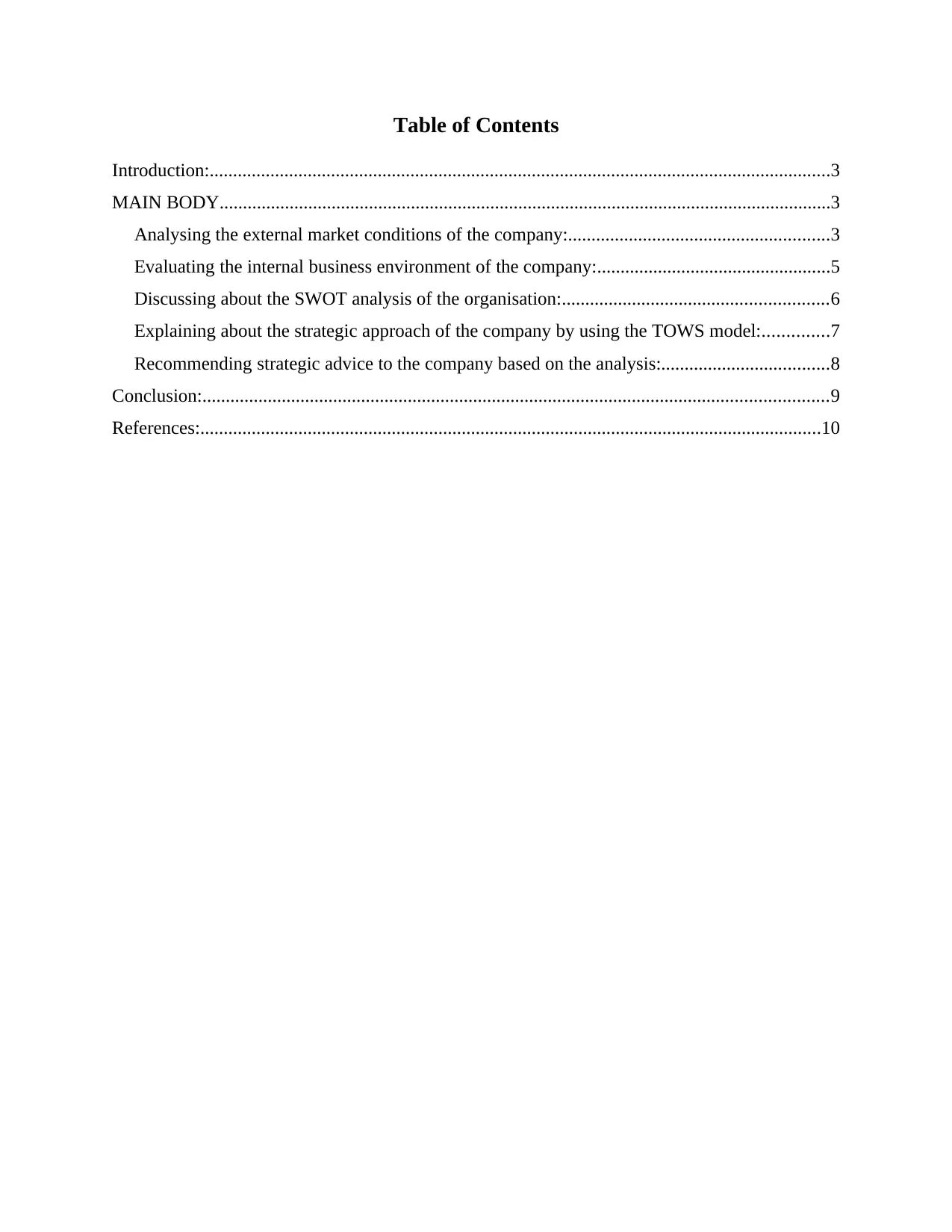
Table of Contents
Introduction:.....................................................................................................................................3
MAIN BODY...................................................................................................................................3
Analysing the external market conditions of the company:........................................................3
Evaluating the internal business environment of the company:..................................................5
Discussing about the SWOT analysis of the organisation:.........................................................6
Explaining about the strategic approach of the company by using the TOWS model:..............7
Recommending strategic advice to the company based on the analysis:....................................8
Conclusion:......................................................................................................................................9
References:.....................................................................................................................................10
Introduction:.....................................................................................................................................3
MAIN BODY...................................................................................................................................3
Analysing the external market conditions of the company:........................................................3
Evaluating the internal business environment of the company:..................................................5
Discussing about the SWOT analysis of the organisation:.........................................................6
Explaining about the strategic approach of the company by using the TOWS model:..............7
Recommending strategic advice to the company based on the analysis:....................................8
Conclusion:......................................................................................................................................9
References:.....................................................................................................................................10
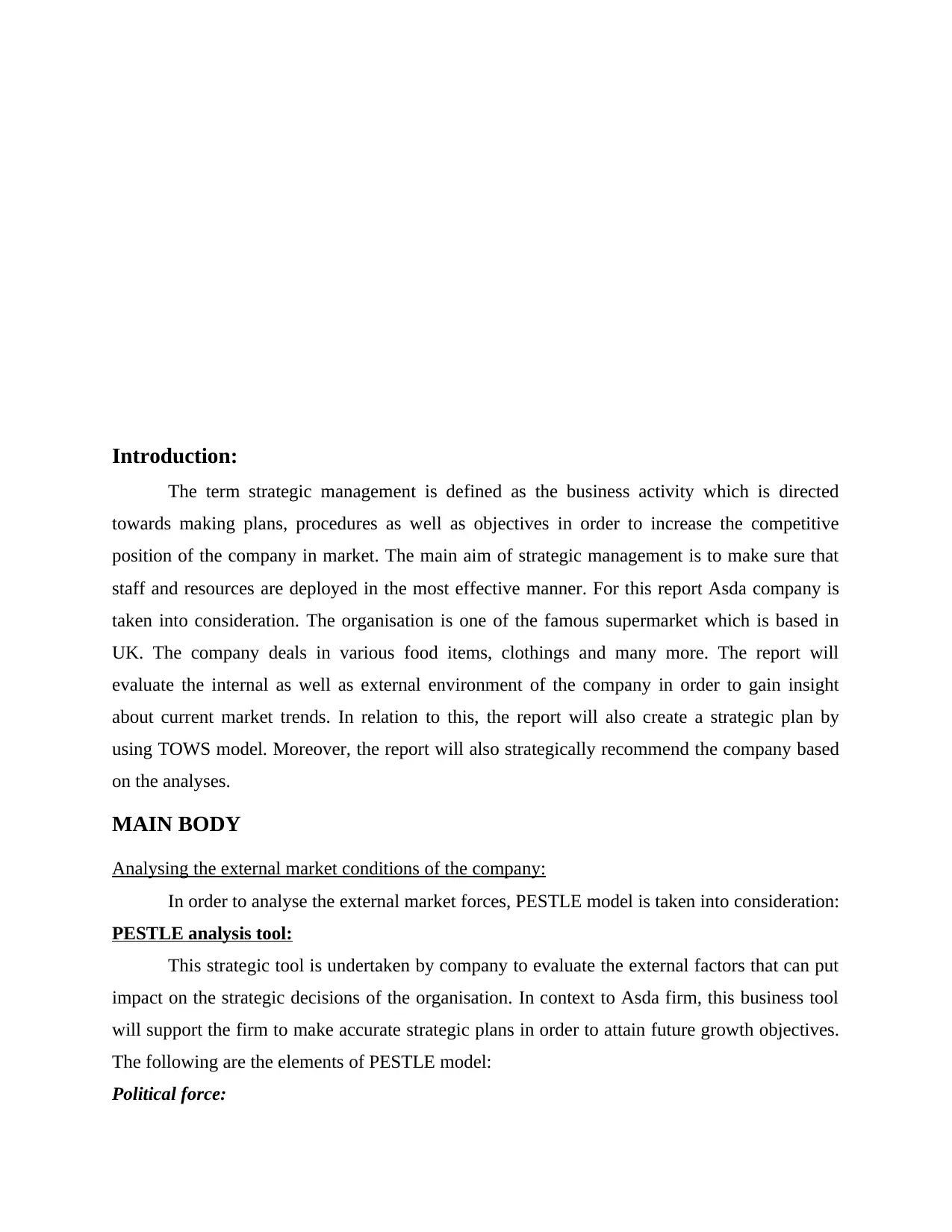
Introduction:
The term strategic management is defined as the business activity which is directed
towards making plans, procedures as well as objectives in order to increase the competitive
position of the company in market. The main aim of strategic management is to make sure that
staff and resources are deployed in the most effective manner. For this report Asda company is
taken into consideration. The organisation is one of the famous supermarket which is based in
UK. The company deals in various food items, clothings and many more. The report will
evaluate the internal as well as external environment of the company in order to gain insight
about current market trends. In relation to this, the report will also create a strategic plan by
using TOWS model. Moreover, the report will also strategically recommend the company based
on the analyses.
MAIN BODY
Analysing the external market conditions of the company:
In order to analyse the external market forces, PESTLE model is taken into consideration:
PESTLE analysis tool:
This strategic tool is undertaken by company to evaluate the external factors that can put
impact on the strategic decisions of the organisation. In context to Asda firm, this business tool
will support the firm to make accurate strategic plans in order to attain future growth objectives.
The following are the elements of PESTLE model:
Political force:
The term strategic management is defined as the business activity which is directed
towards making plans, procedures as well as objectives in order to increase the competitive
position of the company in market. The main aim of strategic management is to make sure that
staff and resources are deployed in the most effective manner. For this report Asda company is
taken into consideration. The organisation is one of the famous supermarket which is based in
UK. The company deals in various food items, clothings and many more. The report will
evaluate the internal as well as external environment of the company in order to gain insight
about current market trends. In relation to this, the report will also create a strategic plan by
using TOWS model. Moreover, the report will also strategically recommend the company based
on the analyses.
MAIN BODY
Analysing the external market conditions of the company:
In order to analyse the external market forces, PESTLE model is taken into consideration:
PESTLE analysis tool:
This strategic tool is undertaken by company to evaluate the external factors that can put
impact on the strategic decisions of the organisation. In context to Asda firm, this business tool
will support the firm to make accurate strategic plans in order to attain future growth objectives.
The following are the elements of PESTLE model:
Political force:
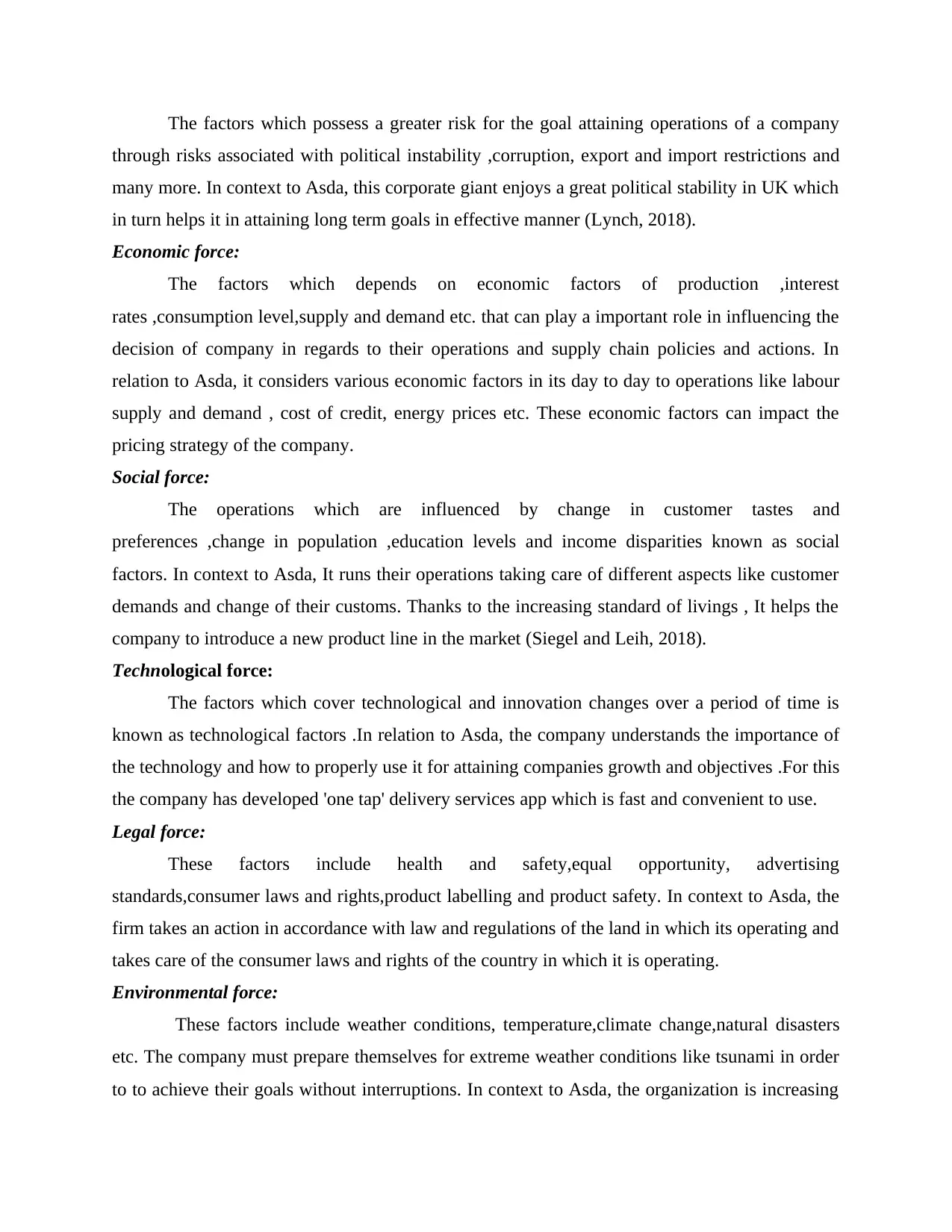
The factors which possess a greater risk for the goal attaining operations of a company
through risks associated with political instability ,corruption, export and import restrictions and
many more. In context to Asda, this corporate giant enjoys a great political stability in UK which
in turn helps it in attaining long term goals in effective manner (Lynch, 2018).
Economic force:
The factors which depends on economic factors of production ,interest
rates ,consumption level,supply and demand etc. that can play a important role in influencing the
decision of company in regards to their operations and supply chain policies and actions. In
relation to Asda, it considers various economic factors in its day to day to operations like labour
supply and demand , cost of credit, energy prices etc. These economic factors can impact the
pricing strategy of the company.
Social force:
The operations which are influenced by change in customer tastes and
preferences ,change in population ,education levels and income disparities known as social
factors. In context to Asda, It runs their operations taking care of different aspects like customer
demands and change of their customs. Thanks to the increasing standard of livings , It helps the
company to introduce a new product line in the market (Siegel and Leih, 2018).
Technological force:
The factors which cover technological and innovation changes over a period of time is
known as technological factors .In relation to Asda, the company understands the importance of
the technology and how to properly use it for attaining companies growth and objectives .For this
the company has developed 'one tap' delivery services app which is fast and convenient to use.
Legal force:
These factors include health and safety,equal opportunity, advertising
standards,consumer laws and rights,product labelling and product safety. In context to Asda, the
firm takes an action in accordance with law and regulations of the land in which its operating and
takes care of the consumer laws and rights of the country in which it is operating.
Environmental force:
These factors include weather conditions, temperature,climate change,natural disasters
etc. The company must prepare themselves for extreme weather conditions like tsunami in order
to to achieve their goals without interruptions. In context to Asda, the organization is increasing
through risks associated with political instability ,corruption, export and import restrictions and
many more. In context to Asda, this corporate giant enjoys a great political stability in UK which
in turn helps it in attaining long term goals in effective manner (Lynch, 2018).
Economic force:
The factors which depends on economic factors of production ,interest
rates ,consumption level,supply and demand etc. that can play a important role in influencing the
decision of company in regards to their operations and supply chain policies and actions. In
relation to Asda, it considers various economic factors in its day to day to operations like labour
supply and demand , cost of credit, energy prices etc. These economic factors can impact the
pricing strategy of the company.
Social force:
The operations which are influenced by change in customer tastes and
preferences ,change in population ,education levels and income disparities known as social
factors. In context to Asda, It runs their operations taking care of different aspects like customer
demands and change of their customs. Thanks to the increasing standard of livings , It helps the
company to introduce a new product line in the market (Siegel and Leih, 2018).
Technological force:
The factors which cover technological and innovation changes over a period of time is
known as technological factors .In relation to Asda, the company understands the importance of
the technology and how to properly use it for attaining companies growth and objectives .For this
the company has developed 'one tap' delivery services app which is fast and convenient to use.
Legal force:
These factors include health and safety,equal opportunity, advertising
standards,consumer laws and rights,product labelling and product safety. In context to Asda, the
firm takes an action in accordance with law and regulations of the land in which its operating and
takes care of the consumer laws and rights of the country in which it is operating.
Environmental force:
These factors include weather conditions, temperature,climate change,natural disasters
etc. The company must prepare themselves for extreme weather conditions like tsunami in order
to to achieve their goals without interruptions. In context to Asda, the organization is increasing
Secure Best Marks with AI Grader
Need help grading? Try our AI Grader for instant feedback on your assignments.
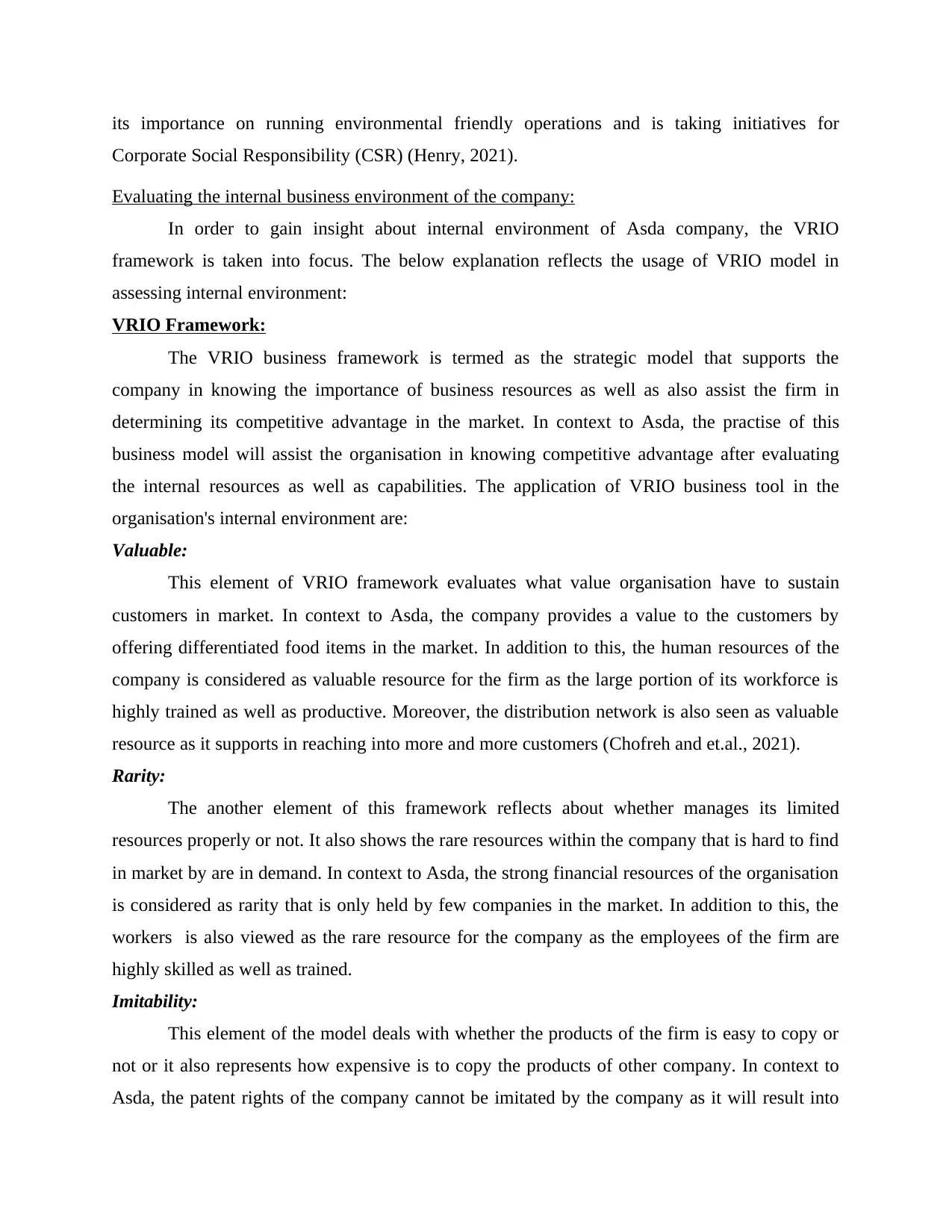
its importance on running environmental friendly operations and is taking initiatives for
Corporate Social Responsibility (CSR) (Henry, 2021).
Evaluating the internal business environment of the company:
In order to gain insight about internal environment of Asda company, the VRIO
framework is taken into focus. The below explanation reflects the usage of VRIO model in
assessing internal environment:
VRIO Framework:
The VRIO business framework is termed as the strategic model that supports the
company in knowing the importance of business resources as well as also assist the firm in
determining its competitive advantage in the market. In context to Asda, the practise of this
business model will assist the organisation in knowing competitive advantage after evaluating
the internal resources as well as capabilities. The application of VRIO business tool in the
organisation's internal environment are:
Valuable:
This element of VRIO framework evaluates what value organisation have to sustain
customers in market. In context to Asda, the company provides a value to the customers by
offering differentiated food items in the market. In addition to this, the human resources of the
company is considered as valuable resource for the firm as the large portion of its workforce is
highly trained as well as productive. Moreover, the distribution network is also seen as valuable
resource as it supports in reaching into more and more customers (Chofreh and et.al., 2021).
Rarity:
The another element of this framework reflects about whether manages its limited
resources properly or not. It also shows the rare resources within the company that is hard to find
in market by are in demand. In context to Asda, the strong financial resources of the organisation
is considered as rarity that is only held by few companies in the market. In addition to this, the
workers is also viewed as the rare resource for the company as the employees of the firm are
highly skilled as well as trained.
Imitability:
This element of the model deals with whether the products of the firm is easy to copy or
not or it also represents how expensive is to copy the products of other company. In context to
Asda, the patent rights of the company cannot be imitated by the company as it will result into
Corporate Social Responsibility (CSR) (Henry, 2021).
Evaluating the internal business environment of the company:
In order to gain insight about internal environment of Asda company, the VRIO
framework is taken into focus. The below explanation reflects the usage of VRIO model in
assessing internal environment:
VRIO Framework:
The VRIO business framework is termed as the strategic model that supports the
company in knowing the importance of business resources as well as also assist the firm in
determining its competitive advantage in the market. In context to Asda, the practise of this
business model will assist the organisation in knowing competitive advantage after evaluating
the internal resources as well as capabilities. The application of VRIO business tool in the
organisation's internal environment are:
Valuable:
This element of VRIO framework evaluates what value organisation have to sustain
customers in market. In context to Asda, the company provides a value to the customers by
offering differentiated food items in the market. In addition to this, the human resources of the
company is considered as valuable resource for the firm as the large portion of its workforce is
highly trained as well as productive. Moreover, the distribution network is also seen as valuable
resource as it supports in reaching into more and more customers (Chofreh and et.al., 2021).
Rarity:
The another element of this framework reflects about whether manages its limited
resources properly or not. It also shows the rare resources within the company that is hard to find
in market by are in demand. In context to Asda, the strong financial resources of the organisation
is considered as rarity that is only held by few companies in the market. In addition to this, the
workers is also viewed as the rare resource for the company as the employees of the firm are
highly skilled as well as trained.
Imitability:
This element of the model deals with whether the products of the firm is easy to copy or
not or it also represents how expensive is to copy the products of other company. In context to
Asda, the patent rights of the company cannot be imitated by the company as it will result into
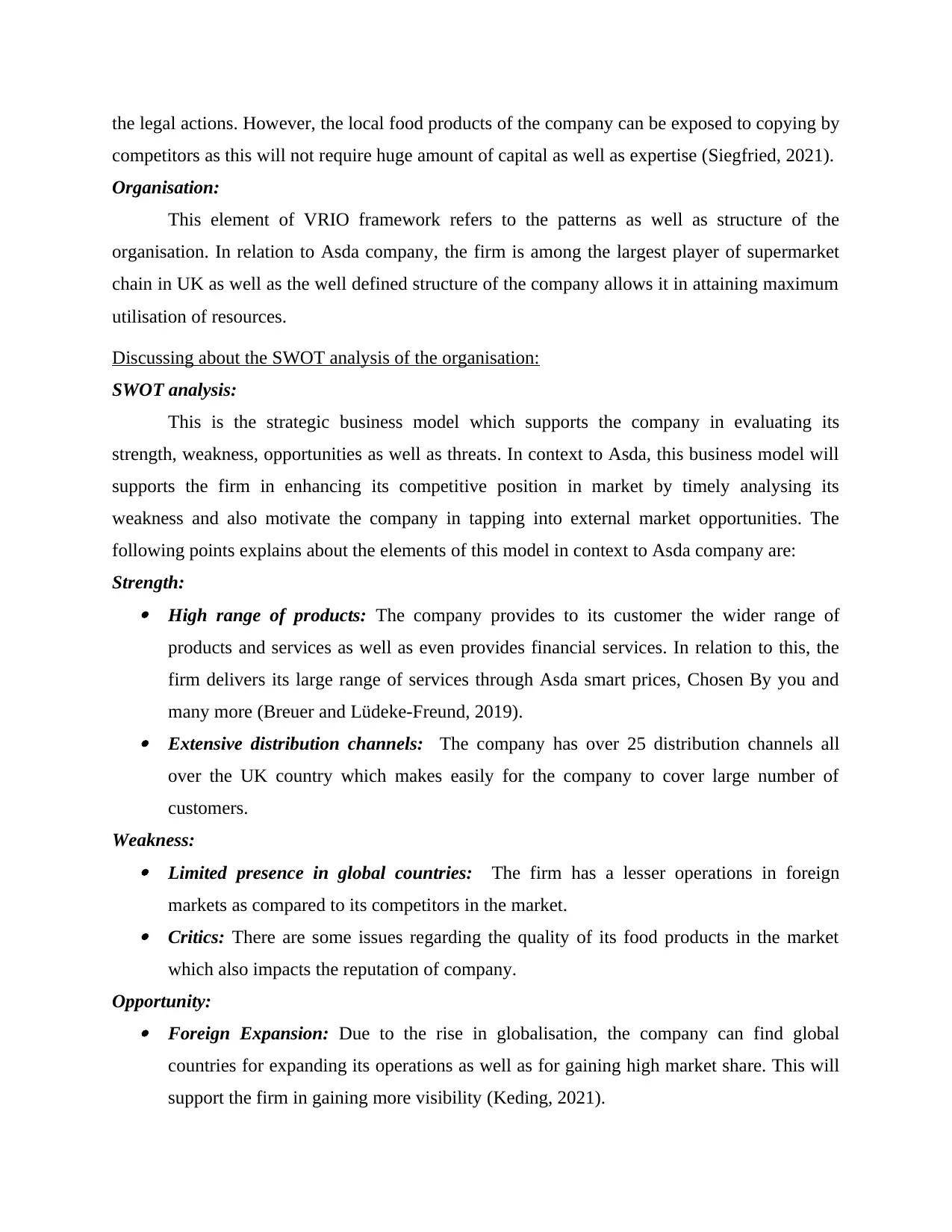
the legal actions. However, the local food products of the company can be exposed to copying by
competitors as this will not require huge amount of capital as well as expertise (Siegfried, 2021).
Organisation:
This element of VRIO framework refers to the patterns as well as structure of the
organisation. In relation to Asda company, the firm is among the largest player of supermarket
chain in UK as well as the well defined structure of the company allows it in attaining maximum
utilisation of resources.
Discussing about the SWOT analysis of the organisation:
SWOT analysis:
This is the strategic business model which supports the company in evaluating its
strength, weakness, opportunities as well as threats. In context to Asda, this business model will
supports the firm in enhancing its competitive position in market by timely analysing its
weakness and also motivate the company in tapping into external market opportunities. The
following points explains about the elements of this model in context to Asda company are:
Strength: High range of products: The company provides to its customer the wider range of
products and services as well as even provides financial services. In relation to this, the
firm delivers its large range of services through Asda smart prices, Chosen By you and
many more (Breuer and Lüdeke-Freund, 2019). Extensive distribution channels: The company has over 25 distribution channels all
over the UK country which makes easily for the company to cover large number of
customers.
Weakness: Limited presence in global countries: The firm has a lesser operations in foreign
markets as compared to its competitors in the market. Critics: There are some issues regarding the quality of its food products in the market
which also impacts the reputation of company.
Opportunity: Foreign Expansion: Due to the rise in globalisation, the company can find global
countries for expanding its operations as well as for gaining high market share. This will
support the firm in gaining more visibility (Keding, 2021).
competitors as this will not require huge amount of capital as well as expertise (Siegfried, 2021).
Organisation:
This element of VRIO framework refers to the patterns as well as structure of the
organisation. In relation to Asda company, the firm is among the largest player of supermarket
chain in UK as well as the well defined structure of the company allows it in attaining maximum
utilisation of resources.
Discussing about the SWOT analysis of the organisation:
SWOT analysis:
This is the strategic business model which supports the company in evaluating its
strength, weakness, opportunities as well as threats. In context to Asda, this business model will
supports the firm in enhancing its competitive position in market by timely analysing its
weakness and also motivate the company in tapping into external market opportunities. The
following points explains about the elements of this model in context to Asda company are:
Strength: High range of products: The company provides to its customer the wider range of
products and services as well as even provides financial services. In relation to this, the
firm delivers its large range of services through Asda smart prices, Chosen By you and
many more (Breuer and Lüdeke-Freund, 2019). Extensive distribution channels: The company has over 25 distribution channels all
over the UK country which makes easily for the company to cover large number of
customers.
Weakness: Limited presence in global countries: The firm has a lesser operations in foreign
markets as compared to its competitors in the market. Critics: There are some issues regarding the quality of its food products in the market
which also impacts the reputation of company.
Opportunity: Foreign Expansion: Due to the rise in globalisation, the company can find global
countries for expanding its operations as well as for gaining high market share. This will
support the firm in gaining more visibility (Keding, 2021).
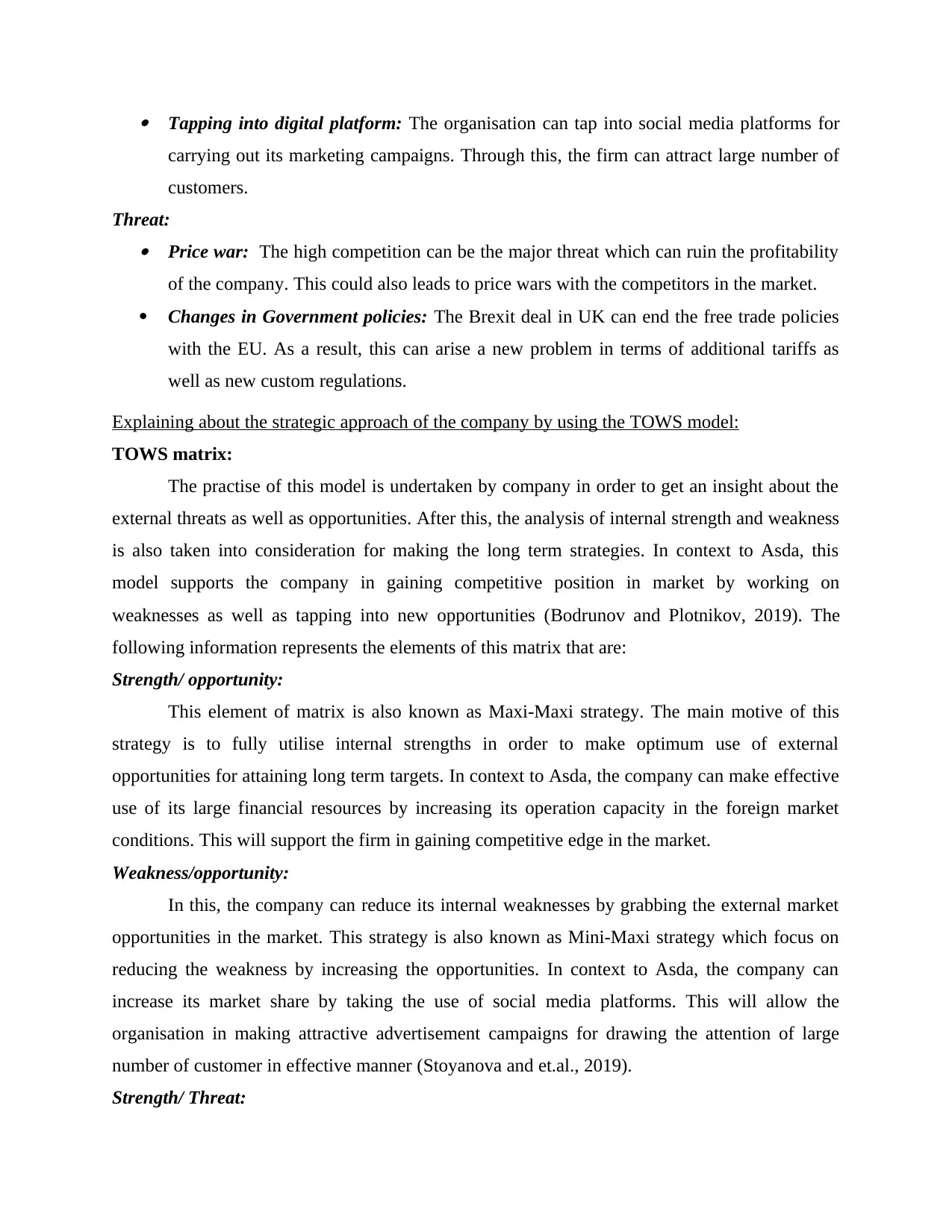
Tapping into digital platform: The organisation can tap into social media platforms for
carrying out its marketing campaigns. Through this, the firm can attract large number of
customers.
Threat: Price war: The high competition can be the major threat which can ruin the profitability
of the company. This could also leads to price wars with the competitors in the market.
Changes in Government policies: The Brexit deal in UK can end the free trade policies
with the EU. As a result, this can arise a new problem in terms of additional tariffs as
well as new custom regulations.
Explaining about the strategic approach of the company by using the TOWS model:
TOWS matrix:
The practise of this model is undertaken by company in order to get an insight about the
external threats as well as opportunities. After this, the analysis of internal strength and weakness
is also taken into consideration for making the long term strategies. In context to Asda, this
model supports the company in gaining competitive position in market by working on
weaknesses as well as tapping into new opportunities (Bodrunov and Plotnikov, 2019). The
following information represents the elements of this matrix that are:
Strength/ opportunity:
This element of matrix is also known as Maxi-Maxi strategy. The main motive of this
strategy is to fully utilise internal strengths in order to make optimum use of external
opportunities for attaining long term targets. In context to Asda, the company can make effective
use of its large financial resources by increasing its operation capacity in the foreign market
conditions. This will support the firm in gaining competitive edge in the market.
Weakness/opportunity:
In this, the company can reduce its internal weaknesses by grabbing the external market
opportunities in the market. This strategy is also known as Mini-Maxi strategy which focus on
reducing the weakness by increasing the opportunities. In context to Asda, the company can
increase its market share by taking the use of social media platforms. This will allow the
organisation in making attractive advertisement campaigns for drawing the attention of large
number of customer in effective manner (Stoyanova and et.al., 2019).
Strength/ Threat:
carrying out its marketing campaigns. Through this, the firm can attract large number of
customers.
Threat: Price war: The high competition can be the major threat which can ruin the profitability
of the company. This could also leads to price wars with the competitors in the market.
Changes in Government policies: The Brexit deal in UK can end the free trade policies
with the EU. As a result, this can arise a new problem in terms of additional tariffs as
well as new custom regulations.
Explaining about the strategic approach of the company by using the TOWS model:
TOWS matrix:
The practise of this model is undertaken by company in order to get an insight about the
external threats as well as opportunities. After this, the analysis of internal strength and weakness
is also taken into consideration for making the long term strategies. In context to Asda, this
model supports the company in gaining competitive position in market by working on
weaknesses as well as tapping into new opportunities (Bodrunov and Plotnikov, 2019). The
following information represents the elements of this matrix that are:
Strength/ opportunity:
This element of matrix is also known as Maxi-Maxi strategy. The main motive of this
strategy is to fully utilise internal strengths in order to make optimum use of external
opportunities for attaining long term targets. In context to Asda, the company can make effective
use of its large financial resources by increasing its operation capacity in the foreign market
conditions. This will support the firm in gaining competitive edge in the market.
Weakness/opportunity:
In this, the company can reduce its internal weaknesses by grabbing the external market
opportunities in the market. This strategy is also known as Mini-Maxi strategy which focus on
reducing the weakness by increasing the opportunities. In context to Asda, the company can
increase its market share by taking the use of social media platforms. This will allow the
organisation in making attractive advertisement campaigns for drawing the attention of large
number of customer in effective manner (Stoyanova and et.al., 2019).
Strength/ Threat:
Paraphrase This Document
Need a fresh take? Get an instant paraphrase of this document with our AI Paraphraser
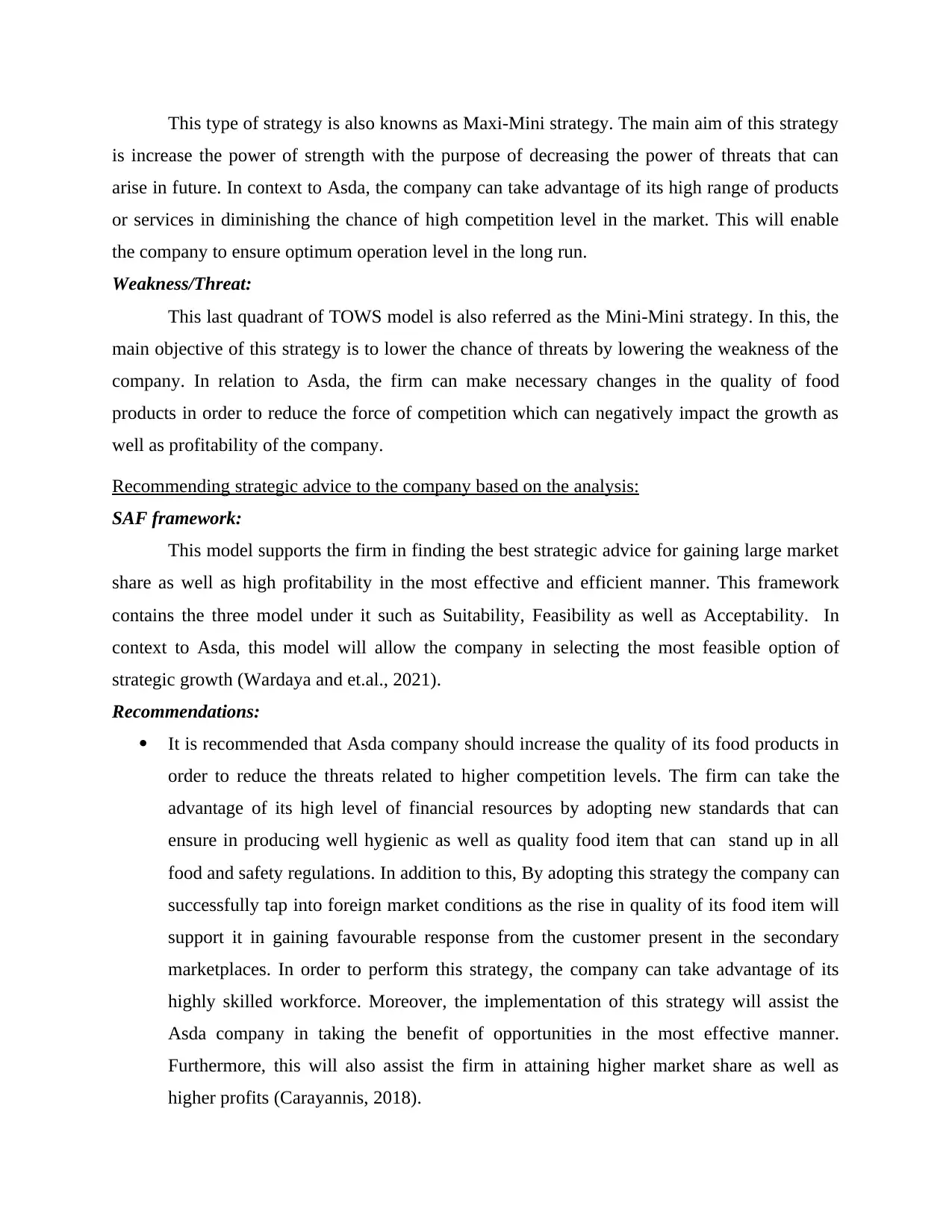
This type of strategy is also knowns as Maxi-Mini strategy. The main aim of this strategy
is increase the power of strength with the purpose of decreasing the power of threats that can
arise in future. In context to Asda, the company can take advantage of its high range of products
or services in diminishing the chance of high competition level in the market. This will enable
the company to ensure optimum operation level in the long run.
Weakness/Threat:
This last quadrant of TOWS model is also referred as the Mini-Mini strategy. In this, the
main objective of this strategy is to lower the chance of threats by lowering the weakness of the
company. In relation to Asda, the firm can make necessary changes in the quality of food
products in order to reduce the force of competition which can negatively impact the growth as
well as profitability of the company.
Recommending strategic advice to the company based on the analysis:
SAF framework:
This model supports the firm in finding the best strategic advice for gaining large market
share as well as high profitability in the most effective and efficient manner. This framework
contains the three model under it such as Suitability, Feasibility as well as Acceptability. In
context to Asda, this model will allow the company in selecting the most feasible option of
strategic growth (Wardaya and et.al., 2021).
Recommendations:
It is recommended that Asda company should increase the quality of its food products in
order to reduce the threats related to higher competition levels. The firm can take the
advantage of its high level of financial resources by adopting new standards that can
ensure in producing well hygienic as well as quality food item that can stand up in all
food and safety regulations. In addition to this, By adopting this strategy the company can
successfully tap into foreign market conditions as the rise in quality of its food item will
support it in gaining favourable response from the customer present in the secondary
marketplaces. In order to perform this strategy, the company can take advantage of its
highly skilled workforce. Moreover, the implementation of this strategy will assist the
Asda company in taking the benefit of opportunities in the most effective manner.
Furthermore, this will also assist the firm in attaining higher market share as well as
higher profits (Carayannis, 2018).
is increase the power of strength with the purpose of decreasing the power of threats that can
arise in future. In context to Asda, the company can take advantage of its high range of products
or services in diminishing the chance of high competition level in the market. This will enable
the company to ensure optimum operation level in the long run.
Weakness/Threat:
This last quadrant of TOWS model is also referred as the Mini-Mini strategy. In this, the
main objective of this strategy is to lower the chance of threats by lowering the weakness of the
company. In relation to Asda, the firm can make necessary changes in the quality of food
products in order to reduce the force of competition which can negatively impact the growth as
well as profitability of the company.
Recommending strategic advice to the company based on the analysis:
SAF framework:
This model supports the firm in finding the best strategic advice for gaining large market
share as well as high profitability in the most effective and efficient manner. This framework
contains the three model under it such as Suitability, Feasibility as well as Acceptability. In
context to Asda, this model will allow the company in selecting the most feasible option of
strategic growth (Wardaya and et.al., 2021).
Recommendations:
It is recommended that Asda company should increase the quality of its food products in
order to reduce the threats related to higher competition levels. The firm can take the
advantage of its high level of financial resources by adopting new standards that can
ensure in producing well hygienic as well as quality food item that can stand up in all
food and safety regulations. In addition to this, By adopting this strategy the company can
successfully tap into foreign market conditions as the rise in quality of its food item will
support it in gaining favourable response from the customer present in the secondary
marketplaces. In order to perform this strategy, the company can take advantage of its
highly skilled workforce. Moreover, the implementation of this strategy will assist the
Asda company in taking the benefit of opportunities in the most effective manner.
Furthermore, this will also assist the firm in attaining higher market share as well as
higher profits (Carayannis, 2018).
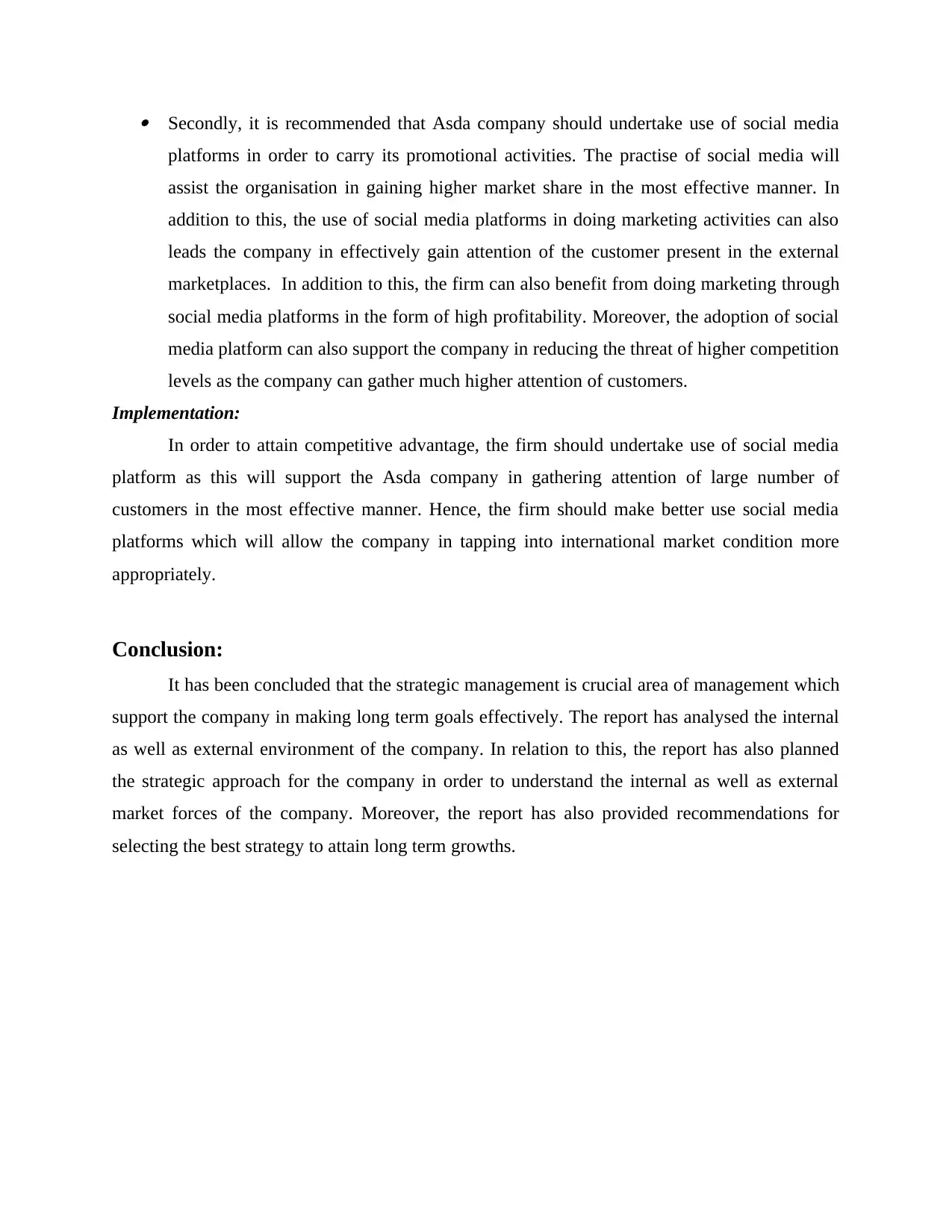
Secondly, it is recommended that Asda company should undertake use of social media
platforms in order to carry its promotional activities. The practise of social media will
assist the organisation in gaining higher market share in the most effective manner. In
addition to this, the use of social media platforms in doing marketing activities can also
leads the company in effectively gain attention of the customer present in the external
marketplaces. In addition to this, the firm can also benefit from doing marketing through
social media platforms in the form of high profitability. Moreover, the adoption of social
media platform can also support the company in reducing the threat of higher competition
levels as the company can gather much higher attention of customers.
Implementation:
In order to attain competitive advantage, the firm should undertake use of social media
platform as this will support the Asda company in gathering attention of large number of
customers in the most effective manner. Hence, the firm should make better use social media
platforms which will allow the company in tapping into international market condition more
appropriately.
Conclusion:
It has been concluded that the strategic management is crucial area of management which
support the company in making long term goals effectively. The report has analysed the internal
as well as external environment of the company. In relation to this, the report has also planned
the strategic approach for the company in order to understand the internal as well as external
market forces of the company. Moreover, the report has also provided recommendations for
selecting the best strategy to attain long term growths.
platforms in order to carry its promotional activities. The practise of social media will
assist the organisation in gaining higher market share in the most effective manner. In
addition to this, the use of social media platforms in doing marketing activities can also
leads the company in effectively gain attention of the customer present in the external
marketplaces. In addition to this, the firm can also benefit from doing marketing through
social media platforms in the form of high profitability. Moreover, the adoption of social
media platform can also support the company in reducing the threat of higher competition
levels as the company can gather much higher attention of customers.
Implementation:
In order to attain competitive advantage, the firm should undertake use of social media
platform as this will support the Asda company in gathering attention of large number of
customers in the most effective manner. Hence, the firm should make better use social media
platforms which will allow the company in tapping into international market condition more
appropriately.
Conclusion:
It has been concluded that the strategic management is crucial area of management which
support the company in making long term goals effectively. The report has analysed the internal
as well as external environment of the company. In relation to this, the report has also planned
the strategic approach for the company in order to understand the internal as well as external
market forces of the company. Moreover, the report has also provided recommendations for
selecting the best strategy to attain long term growths.
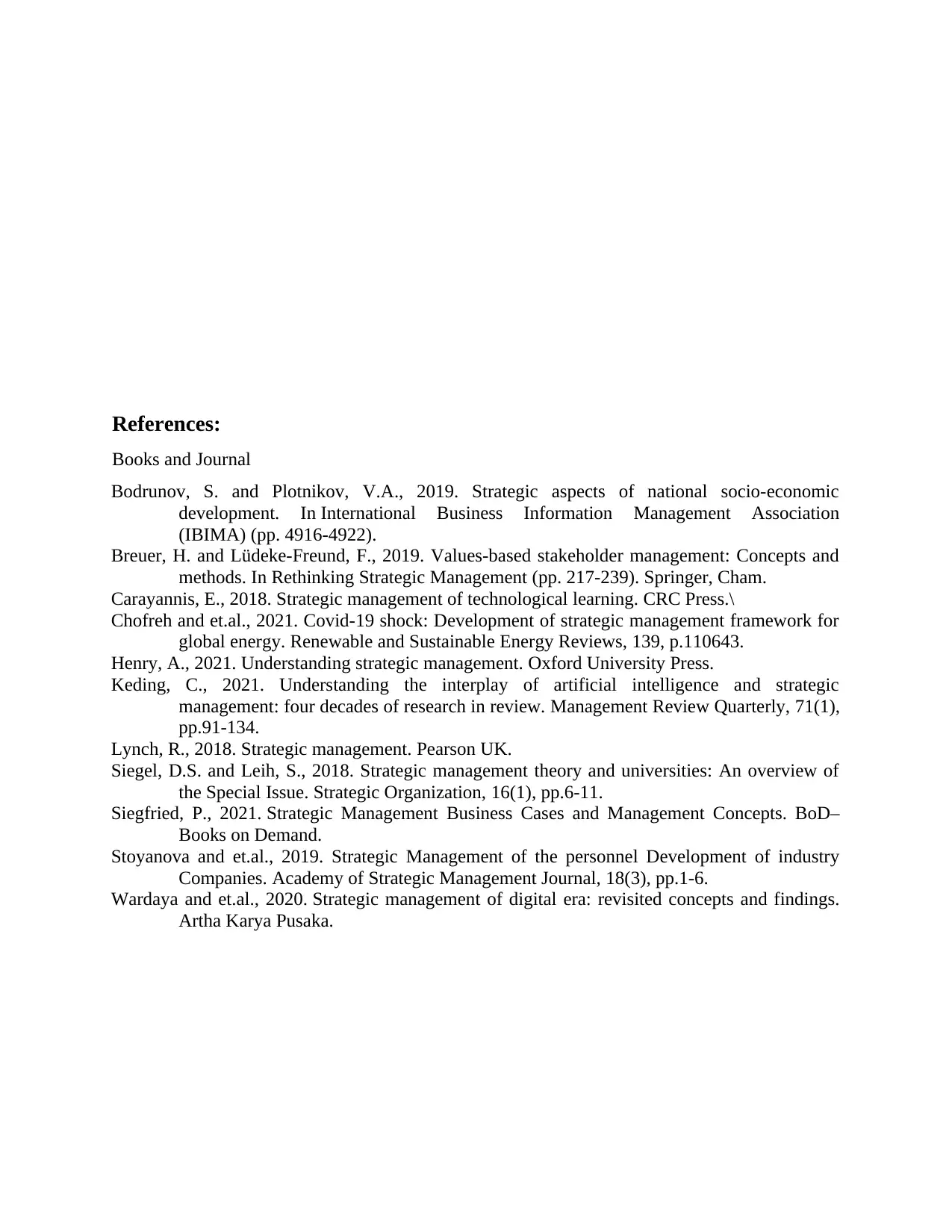
References:
Books and Journal
Bodrunov, S. and Plotnikov, V.A., 2019. Strategic aspects of national socio-economic
development. In International Business Information Management Association
(IBIMA) (pp. 4916-4922).
Breuer, H. and Lüdeke-Freund, F., 2019. Values-based stakeholder management: Concepts and
methods. In Rethinking Strategic Management (pp. 217-239). Springer, Cham.
Carayannis, E., 2018. Strategic management of technological learning. CRC Press.\
Chofreh and et.al., 2021. Covid-19 shock: Development of strategic management framework for
global energy. Renewable and Sustainable Energy Reviews, 139, p.110643.
Henry, A., 2021. Understanding strategic management. Oxford University Press.
Keding, C., 2021. Understanding the interplay of artificial intelligence and strategic
management: four decades of research in review. Management Review Quarterly, 71(1),
pp.91-134.
Lynch, R., 2018. Strategic management. Pearson UK.
Siegel, D.S. and Leih, S., 2018. Strategic management theory and universities: An overview of
the Special Issue. Strategic Organization, 16(1), pp.6-11.
Siegfried, P., 2021. Strategic Management Business Cases and Management Concepts. BoD–
Books on Demand.
Stoyanova and et.al., 2019. Strategic Management of the personnel Development of industry
Companies. Academy of Strategic Management Journal, 18(3), pp.1-6.
Wardaya and et.al., 2020. Strategic management of digital era: revisited concepts and findings.
Artha Karya Pusaka.
Books and Journal
Bodrunov, S. and Plotnikov, V.A., 2019. Strategic aspects of national socio-economic
development. In International Business Information Management Association
(IBIMA) (pp. 4916-4922).
Breuer, H. and Lüdeke-Freund, F., 2019. Values-based stakeholder management: Concepts and
methods. In Rethinking Strategic Management (pp. 217-239). Springer, Cham.
Carayannis, E., 2018. Strategic management of technological learning. CRC Press.\
Chofreh and et.al., 2021. Covid-19 shock: Development of strategic management framework for
global energy. Renewable and Sustainable Energy Reviews, 139, p.110643.
Henry, A., 2021. Understanding strategic management. Oxford University Press.
Keding, C., 2021. Understanding the interplay of artificial intelligence and strategic
management: four decades of research in review. Management Review Quarterly, 71(1),
pp.91-134.
Lynch, R., 2018. Strategic management. Pearson UK.
Siegel, D.S. and Leih, S., 2018. Strategic management theory and universities: An overview of
the Special Issue. Strategic Organization, 16(1), pp.6-11.
Siegfried, P., 2021. Strategic Management Business Cases and Management Concepts. BoD–
Books on Demand.
Stoyanova and et.al., 2019. Strategic Management of the personnel Development of industry
Companies. Academy of Strategic Management Journal, 18(3), pp.1-6.
Wardaya and et.al., 2020. Strategic management of digital era: revisited concepts and findings.
Artha Karya Pusaka.
Secure Best Marks with AI Grader
Need help grading? Try our AI Grader for instant feedback on your assignments.

1 out of 11
Related Documents
Your All-in-One AI-Powered Toolkit for Academic Success.
+13062052269
info@desklib.com
Available 24*7 on WhatsApp / Email
![[object Object]](/_next/static/media/star-bottom.7253800d.svg)
Unlock your academic potential
© 2024 | Zucol Services PVT LTD | All rights reserved.





